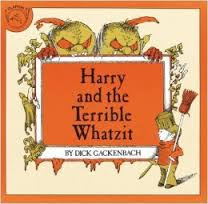Facing Your Fears Activity
Using Harry and the Terrible Whatzit
by Dick Gackenbach
Uses: Discussions/illustrations of bravery, facing fears, empowerment
Ages: 4-12 (higher depending on developmental level and open-mindedness of the student)
Modalities: Group or individual
Activity:
For younger students.
Ask students to define bravery. This can be as quick as simply writing their response on the board, or a short discussion. In groups, students can work in pairs to decide on an answer together. (Young children usually equate bravery with a lack of fear, you may want to briefly discuss if you can be scared and brave at the same time).
Read the book to the students, asking them to look for times when Harry was brave. At the end of the story, ask them if they thought Harry was brave. If it has not been addressed, also ask if Harry was scared. Define bravery as action in the face of fear, not an absence of fear.
Invite the students to draw a picture of their own Whatzit (or something that they really fear). As they are drawing, encourage them to add themselves to the drawing, fighting back/attacking their Whatzit. If you know that the child has a specific fear, you could have them draw that from the beginning, or do a second drawing. This can be repeated as many times as the child would like, each time identifying a specific fear and including the child “standing up” to the scary thing or situation.
For older students:
Ask the students to define bravery individually or in small groups. If there is time, discuss examples of bravery from their own lives or in popular media. Begin discussing the idea that bravery means acting in the face of fear, not the lack of fear. Everyone feels afraid sometimes.
Read the book, or have a group member read the book. Ask the students to identify if Harry was brave and when.
Invite the students to draw a picture of them fighting their own Whatzit or another situation where they fought back against their fears. These can be very realistic or entirely abstract.
Have the students share their drawings, explaining the fearful situation and how they responded. If any of the students get stuck, ask group members for suggestions as to how to face the fear or deal with the situation.
With the oldest students, continue the discussion by making plans for real life situations.
Gackenbach, D. (1977). Harry and the terrible whatzit. New York: Seabury Press.




No comments:
Post a Comment